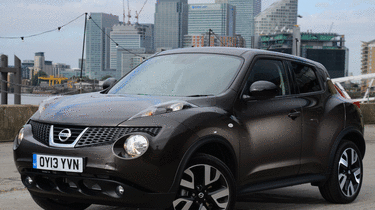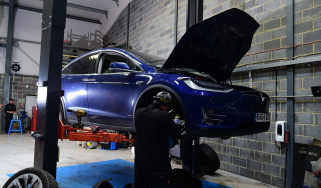Nissan Juke 1.5 dCi n-tec
Can the Nissan Juke fend off crossovers from Peugeot, Renault and Vauxhall? We find out

Despite its new rivals, the Juke still looks like nothing else on the road – in fact it looks more like a frog than ever in the dark green shade of our test car. The new engine adds appeal, but the Nissan still isn’t among the best to drive, and has a small boot that’s a real negative in the class. The Juke started the crossover craze, but other cars now do it better.
The Nissan Juke made compact crossovers a mainstream alternative to ordinary superminis. But the problem with being first is that the Juke has become the benchmark for its rivals to beat. So with new crossovers from Peugeot, Renault and Vauxhall just launched, and the Ford EcoSport on the way, Nissan has uprated the Juke’s 1.5-litre dCi diesel engine to help it stay on the pace. We’ve driven it here in best-selling n-tec form.
Around a third of Jukes sold so far have been powered by the diesel engine, and Nissan claims that share is likely to climb now that it has tweaked the fuel injectors, added a variable-geometry turbo and switched to a more efficient oil pump. This has helped improve the claimed fuel economy from 58.9mpg to 67.3mpg, drop CO2 emissions from 124g/km to 109g/km and means the engine is now Euro 6 compliant.
Used - available now
The engine also includes stop-start, which kicks the engine back into life almost as soon as your foot touches the clutch. Once up and running, it’s pretty smooth and quiet, too – something that Nissan claims is also improved over the previous engine. The Juke also has a new alertness about it in town now, as the ratios of first and second gear have been lowered, giving the car a bit more initial urgency when accelerating away from traffic lights. Although it’s more efficient, the engine has 20Nm more torque, at 260Nm, which is developed from 1,750rpm and also helps make the Juke feel more sprightly.
Juke n-tec models come with a unique design of 18-inch wheels. And while they look the part – and help give the Juke high levels of grip – they give an overly firm and rough ride, particularly when you hit potholes and sharper speedbumps around town. The Juke isn’t a particularly sparkling drive, with pretty numb steering, although it does resist bodyroll fairly well.
Press the ‘D-MODE’ button on the centre console and there are three driving modes to choose from – Normal, Eco and Sport. Normal is the best mix and it’s the one you’ll probably leave it in most of the time, while Sport gives you slightly weightier steering and Eco makes the car feel quite unresponsive, with a less sensitive throttle and a limit to 220Nm on the engine’s torque.
The n-tec model we tested features Nissan’s Connect system. It’s a very simple-to-use infotainment system, with large buttons and clear graphics on the 5.8-inch touchscreen. The system features clever tech like Google Send-To-Car, which allows you to plan a route on your home computer and send the route to your car, and is also very easy to pair your smartphone to, using Bluetooth.











